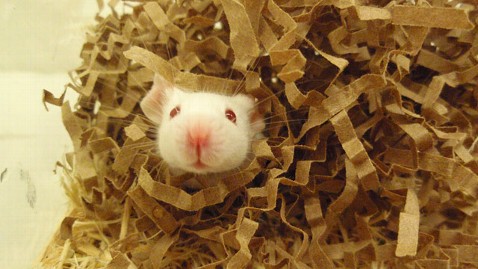Keeping Chilly Lab Mice Warm: Key to Better Science?
 (Image Credit: Brianna Gaskill, Purdue University)
(Image Credit: Brianna Gaskill, Purdue University) Joseph Garner imagines how much happier and healthier lab mice would be in a kinder, gentler environment than the stark cages in chilly laboratories - and how that, in turn, might improve the outcome of research that underlies human medical advances.
In searching for "one thing we could put in every mouse cage in America that would make every mouse better off and would improve the quality of science done with every mouse," he focused on a simple fact: mice are chronically cold and suffer from thermal stress.
That "one thing" that could be put in every cage is turning out to be shredded paper, which chilly mice use to build toasty, warm nests like the ones that wild mice build, according to a study published today in the journal PLoS One.
Given between a fifth and a third of an ounce of crinkly, coarse shredded paper called Enviro-dri, the mice went to work weaving "these beautiful igloos that are just incredible," said Garner, an associate professor of comparative medicine at Stanford University in California. He conducted the research while at Purdue University in Indiana, with his then-graduate student Brianna Gaskill, now a postdoctoral scientist at Charles River Laboratories in Wilmington, Mass.
Because mice are nocturnal creatures, he said the lab mice were busy during nighttime hours in the lab, "very much like 'Where the Wild Things Are.' They're very naughty at night.'"
Garner has devoted much of the last seven years to understanding why 90 percent of compounds that look promising in animals go on to "fail in human trials." He's convinced their environment is part of the answer.
A mouse living in captivity is "a little bit like you or I living in a glass house being looked after by Tyrannosaurus rex," he suggested. And a drafty house at that. That's pretty close to conditions for mice, whose 98.4 degree body temperature is close to the 98.6 degrees of the lab technicians who tend to them. But air temperatures in research laboratories typically are kept between 68 and 75.2 degrees, putting them in a state of "cold stress."
Garner is among the few U.S. scientists "really generating good data to support what animals 'need and want,' because animals clearly have their own needs," said Joanne Zurlo, director of science strategy at the Center for Alternatives to Animal Testing at the Johns Hopkins Bloomberg School of Public Health in Baltimore. Without convincing proof that mouse well-being matters to scientific results, she said other scientists likely won't buy into the idea that they need to make changes after "keeping mice in these conditions for umpteen years."
The world's largest breeder of laboratory mice, which has been supplying mice for the research, recognizes the important influence of laboratory conditions.
"The animal's environment is a crucial factor in research," said Kathleen Pritchett-Corning, director of research and professional services for Charles River Laboratories. "In research, we can control almost all aspects of an animal's environment, but we don't always know what's best for the animal."
She said the company has been "testing this material for our own use and have been very pleased with the results thus far." She also suggested providing lab mice with nesting materials "could be a huge gain in welfare" and that other elements of lab animals' environment are "ripe for study," such as light levels, noise, air movement, type of bedding and feed.
"The healthier and more 'normal' the animal, the better the science," said Pritchett-Corning, a veterinarian who has been working with mice for nearly 20 years. "The better the science, the more likely it is to lead to discoveries and advances that affect human health. It doesn't matter what kind of animal it is, it deserves the best care we can provide."